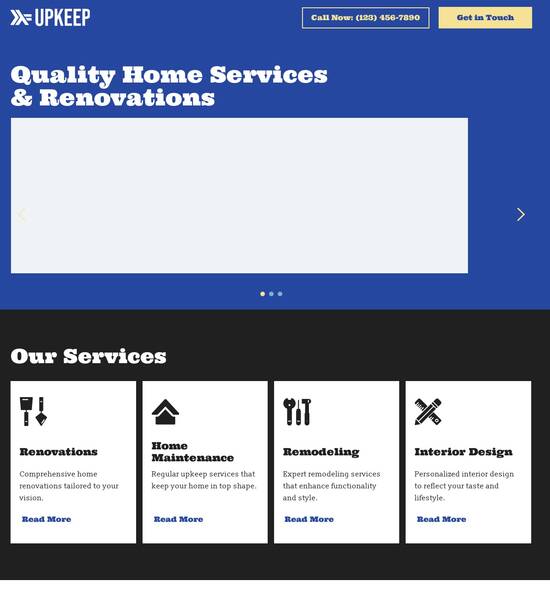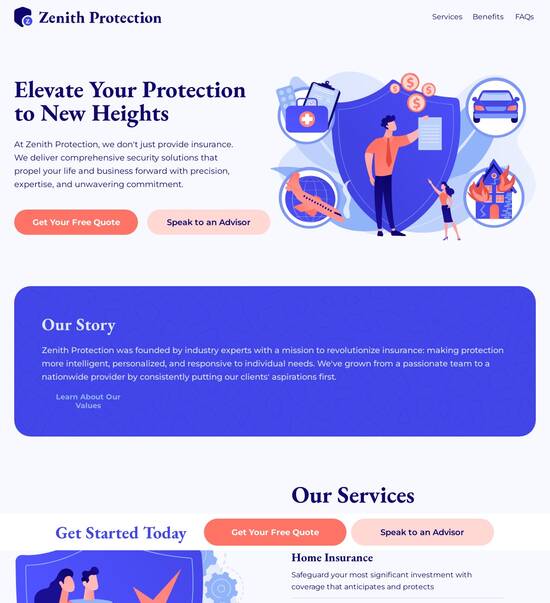
Microsite template for Project schedulers
Explore Similar TemplatesAbout template
Achieve your online goals with the microsite template for Project schedulers.
Recommended templates

Easy to build without coding
With the intuitive drag-and-drop builder, anyone on your team can create high-converting pages without any knowledge of code or design. Make enhancements to your landing page with custom widgets using Javascript, HTML/CSS, or third-party scripts.

Multiple layouts for any industry and goal
Select from 500+ landing page layouts built to boost conversions across industry-specific scenarios. Customize them by adjusting fonts, adding images, and generating on-brand content with the AI assistant. Quickly scale with Instablocks® and Global Blocks that you can save, reuse, and update globally.

Loads fast and looks polished on any device
Every template is responsive, which means they present professionally on any device and load blazingly fast with our Thor Render Engine. You can also power them up with Google AMP technology to deliver an unparalleled mobile experience and drive higher conversions.

Robust analytics & experimentation
Get real-time updates and reporting across all your devices, showing the number of visitors, conversions, cost-per-visitor, and cost-per-lead. Launch AI-powered experiments, run A/B tests, and use heatmaps to analyze user behavior, then optimize your landing page to maximize conversions.







Easy to build without coding
With the intuitive drag-and-drop builder, anyone on your team can create high-converting pages without any knowledge of code or design. Make enhancements to your landing page with custom widgets using Javascript, HTML/CSS, or third-party scripts.
Multiple layouts for any industry and goal
Select from 500+ landing page layouts built to boost conversions across industry-specific scenarios. Customize them by adjusting fonts, adding images, and generating on-brand content with the AI assistant. Quickly scale with Instablocks® and Global Blocks that you can save, reuse, and update globally.
Loads fast and looks polished on any device
Every template is responsive, which means they present professionally on any device and load blazingly fast with our Thor Render Engine.
Robust analytics & experimentation
Get real-time updates and reporting across all your devices, showing the number of visitors, conversions, cost-per-visitor, and cost-per-lead. Launch AI-powered experiments, run A/B tests, and use heatmaps to analyze user behavior, then optimize your landing page to maximize conversions.
All the features you need to build lead-generating landing pages
Explore more featuresLearn how to build top-performing landing pages for any goal
FAQs
Leading the way in building high-performing landing pages





A comprehensive guide to using the Instapage landing page templates for business services
Creating effective landing pages is crucial for marketers in various sectors, such as business services, tech, and education. Instapage offers a powerful CRO platform that simplifies page creation with a wide range of high-converting templates designed to enhance your marketing campaigns. This guide will walk you through the essential steps to maximize your campaign efforts using Instapage.
Understanding the importance of landing pages
Landing pages are pivotal in converting visitors into leads. By utilizing tailored templates from Instapage, marketers can establish focused campaigns aimed at specific audience segments, improving the overall return on investment (ROI). These pages are designed to be responsive, ensuring a consistent user experience across devices, which is vital in today's mobile-first environment.
- Improved conversion rates: Custom landing pages can increase leads by over 30%.
- Targeted messaging: Align your landing page content with specific campaigns for better audience engagement.
- Data-driven insights: Leverage analytics tools available within Instapage to refine your approach continuously.
Step 1: Accessing Instapage templates
To start creating effective landing pages, first access Instapage templates.
- Browse the template library: Explore over 100 pre-designed options tailored for various industries.
- Select a template: Choose one that aligns with your campaign goals and target audience.
- Customize your template: Use the visual editor to modify text, images, and lead generation elements per your needs.
Step 2: Optimizing your landing pages
Once your pages are set up, optimization is crucial for maximizing conversions.
- A/B testing: Utilize built-in A/B testing features to determine which elements perform best.
- Heatmap analysis: Review heatmaps to identify how users interact with your pages, allowing for targeted improvements.
- Personalization: Incorporate dynamic text replacement to match visitor searches with relevant content.
Step 3: Monitoring performance and making adjustments
After launching your landing pages, continuous performance monitoring is essential.
- Analytics dashboard: Use the comprehensive analytics dashboard to track key metrics.
- Adjust based on data: Modify your pages based on performance insights to enhance conversion rates further.
- Collaboration features: Involve your team by sharing real-time feedback and optimizing pages together.
By following these steps, you can create high-performing landing pages using Instapage that directly respond to your marketing objectives.
Ready to boost your digital marketing campaigns? Start exploring Instapage today and transform your approach to landing pages!
People also ask about Microsite template for Project schedulers
Understanding the microsite template for project schedulers
Evolution of project scheduling tools
Project scheduling has come a long way since its inception. Early project management methods relied heavily on paper-based systems, Gantt charts, and manual tracking. As businesses looked for efficiency, they transitioned from these rudimentary practices to digital tools. This shift dramatically changed how projects were planned and executed, allowing for real-time updates and improved collaboration.
With the rise of the internet and cloud-based solutions, the concept of microsites began to emerge in scheduling. Microsites serve specific purposes and provide tailored experiences for users, making them particularly useful in project management. They streamline the scheduling process, integrating various functionalities into a single platform, thus increasing the overall productivity of project managers.
Core features of a microsite template for project schedulers
A well-designed microsite template for project schedulers embodies a user-centric interface design. Intuitive navigation is essential, as it enhances the user experience by minimizing the learning curve. Such templates often employ visual elements like interactive calendars and charts to drive engagement, allowing users to feel more in control of their scheduling.
Customizable time slots that can accommodate various types of appointments, ensuring flexibility.
Integration of buffer times and the ability to schedule recurring meetings to streamline planning.
Real-time updates that keep all users informed, which is crucial for maintaining an up-to-date schedule.
Effective notification and reminder systems to reduce missed appointments and improve accountability.
Tailoring the microsite experience
One of the key advantages of microsite templates for project schedulers is their adaptability to user needs. Customization options allow the template to be altered based on different industries, such as healthcare, education, or corporate environments. Such flexibility ensures that the template caters not only to the technical requirements but also to the specific preferences of its users.
Personalization features can enhance user interaction by incorporating branding elements or customizable layouts that align with organizational goals. Moreover, microsites can support multiple users, providing collaboration features that enable teams to work together efficiently. This includes defining permissions and roles to streamline scheduling among team members.
Integrations that bridge the gap
A critical aspect of a microsite template for scheduling is its integration capabilities. The ability to connect seamlessly with popular calendar platforms such as Google Calendar and Outlook can significantly enhance its utility. Users can manage appointments across various tools without switching back and forth between applications, which can be a productivity killer.
Integration with task and project management tools to provide a comprehensive view of all project activities.
Utilization of APIs for extended functionalities, allowing businesses to customize and expand the template to meet their needs.
Successful integration examples in diverse business environments that illustrate flexibility and effectiveness.
Elevating user experience through design
The aesthetics of a microsite can significantly influence user engagement. A well-considered color palette that aligns with branding can create a cohesive experience for users. Additionally, incorporating multimedia elements such as videos and images can elevate the design, making the scheduling experience more enjoyable and informative.
Mobile responsiveness is another key focus. With users accessing scheduling tools from various devices, ensuring optimal performance across smartphones, tablets, and desktops is crucial. Similarly, accessibility measures need to be in place to cater to users with disabilities, ensuring an inclusive approach to scheduling.
Leveraging hosting services for optimal performance
Choosing the right hosting service is fundamental for the success of a microsite template. Providers should be evaluated based on factors like uptime, speed, and customer support. The importance of these factors cannot be overstated, as they directly impact user satisfaction and the reliability of the scheduling tool.
Identify key factors such as performance, reliability, and customer service when selecting a service.
Consider the implications of domain names on branding, as a good domain enhances recall and trust for users.
Utilize techniques for easy domain management to ensure that the scheduling platform remains consistently accessible.
The psychology of scheduling and user behavior
Understanding user motivations is key to designing effective microsites. Users often seek efficiency, simplicity, and trust in scheduling tools. When these needs are met, users are more likely to engage and return to the platform for future scheduling needs.
Behavioral triggers also play a significant role in user preference. Features such as user reviews and testimonials can foster a sense of trust, while easily navigable interfaces can reduce frustration. Continuous feedback mechanisms are essential for improvement; collecting user suggestions helps to fine-tune the template over time.
Real-world applications and case studies
The application of microsite templates for project scheduling is vast and varied across different industries. In healthcare, for example, scheduling templates can manage patient appointments efficiently, leading to better patient flow and service delivery. Similarly, educational institutions can utilize these microsites for coordinating classes and faculty meetings, simplifying complex scheduling needs.
Case studies showcasing successful implementations of scheduling microsites across sectors.
Metrics and KPIs that reflect the improved scheduling efficiency for businesses.
User testimonials highlight pain points that these tools have effectively addressed.
Future trends in scheduling microsites
As technology continues to evolve, so too will the functionalities of microsite templates for scheduling. Innovations such as AI-driven suggestions and automated scheduling capabilities are on the horizon, making it easier for users to manage their time effectively without manual intervention.
User expectations are also likely to evolve alongside these technological advancements. The shifting landscape demands that businesses remain agile, ready to integrate new features that enhance the user experience. Understanding the trends will enable organizations to offer modern solutions that attract and retain users.
Strategic implementation considerations
For a successful launch of a microsite template, conducting thorough planning and effective deployment strategies are essential. Steps for implementation should include identifying key users to involve in the initial phases, providing adequate training, and ensuring a solid support structure is in place.
Developing strategies for user onboarding that foster quick adaptation.
Frequently encountered challenges, such as resistance to change, and effective solutions to overcome them.
The value of ongoing support and user education to sustain engagement with the microsite.
Ready to skyrocket conversions?
Supercharge your ad campaigns with high-performing landing pages
Get started














